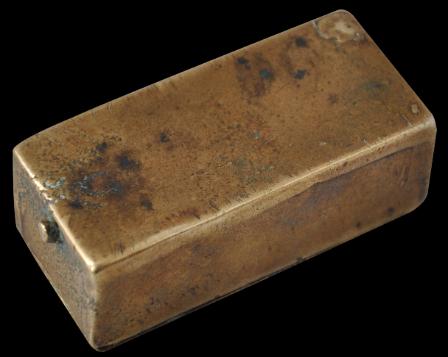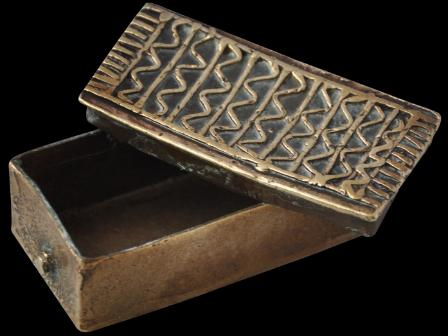
Asante/Ashanti Gold Dust Box
Cast Brass Gold Dust Box
Akan People, Ghana
18th-19th century
length: 6.5cm, height: 2.4cm, width: 3.1cm, weight: 70g
Gold dust was the medium of exchange in West Africa for hundreds of years. Accordingly, a range of paraphernalia associated with storing, handling and weighing gold dust was developed. This box is one such item. It was used for storing and carrying gold dust. It is cast in the manner of the gold weights used in weighing gold themselves – using the lost wax process. The lid fits in the box and fits tightly, even though it has been cast separately. The lid has been cast with a series of wave patterns. Indeed, the box is similar in appearance to the weights used to measure gold dust. Possibly, this was to divert attention from its contents. But equally, it is possible that such boxes were used as weights themselves (Phillips, 2010, p. 20).
The box has excellent patina and very obvious age from many years of handling.
A related box is illustrated in Robbins & Nooter (1989, p. 197). Others are in Phillips (2010).
Gold dust was stored in such boxes. It was kept inside the box wound up in a cloth. Spoons were used to ladle the dust from box to scales. And personal weights were used to weigh gold dust which became the currency used to settle everyday transactions. Each party to any transaction would typically use their own weights. The negotiating process not only would include the cost in gold dust of the items being transacted over but also a comparison of weights, debate over the scales used and the purity of the gold dust (gold often was adulterated with brass filings). Even transactions as rudimentary as buying vegetables in a street market necessitated this process.
Cast brass gold dust paraphernalia was used by the Akan who occupy a large part of West Africa including parts of Ghana and the Ivory Coast and include many sub-ethnic groups such as the Baule and the Asante. Gold became an important commodity which gave rise to Ghana’s old colonial name of the Gold Coast. The region was known as the Gulf of Guinea and in England, a gold coin worth twenty-one shillings became known as a guinea (Philiips, 2010).
References
Phillips, T., African Goldweights: Miniature Sculptures from Ghana 1400-1900, Edition Hansjorg Mayer, 2010.
Robbins, W.M. & N.I. Nooter,
African Art in American Collections, Smithsonian Institution Press, 1989.
Provenance
European art market
Inventory no.: 1403
SOLD




